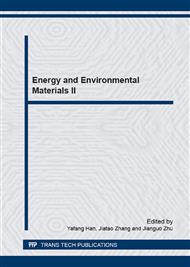[1]
M. Ren, H.G. Wang, L.S. Zou, X.W. Feng, H. Li, Experimental study and theoretical model research of wellbore instability mechanism in a shale gas well, Science Technology and Engineering. 13(2013) 1671-1815.
Google Scholar
[2]
T. Gu, M. Li, Z.S. Wei, X.N. Wang, Z.Y. Li, X.L. Liu, X.Y. Guo, Research development of horizontal shale well cementing technology, Drilling Fluids and Completion Fluid. 30(2013) 75-80.
Google Scholar
[3]
Z.X. Xu, S.B. Guo, Research on accumulation mechanism of shale gas, Inner Mongolia Petrochemical Industry. 6(2011) 122-124.
Google Scholar
[4]
C.L. Wang, G. Li, J.T. Yan, B. Luo, H.B. Liu, X.J. Liu, Experiment study of hard and brittle shale wellbore instability mechanism in south of Sichuan, Science Technology and Engineering. 12(2012) 8012-8015.
Google Scholar
[5]
J.B. Curtis, Fractured shale-gas systems, AAPG Bulletin. 86(2002) 1921–(1938).
Google Scholar
[6]
R. Caenn, G.V. Chillingar, Drilling fluids: State of the art, J. Pet. Sci. Eng. 14(1996) 221-230.
Google Scholar
[7]
M. Dolz, J. Jiménez, M. Jesús Hernández, J. Delegido, A. Casanovas, Flow and thixotropy of non-contaminating oil drilling fluids formulated with bentonite and sodium carboxymethyl cellulose, J. Pet. Sci. Eng. 57(2007) 294-302.
DOI: 10.1016/j.petrol.2006.10.008
Google Scholar
[8]
M. Khodja, J.P. Canselier, F. Bergaya, K. Fourar, M. Khodja, N. Cohaut, A. Benmounah, Shale problems and water-based drilling fluid optimisation in the Hassi Messaoud Algerian oil field, Appl. Clay Sci. 49(2010) 383-393.
DOI: 10.1016/j.clay.2010.06.008
Google Scholar
[9]
V. Mahto and V.P. Sharma, Rheological study of a water based oil well drilling fluid, J. Pet. Sci. Eng. 45(2004) 123-128.
DOI: 10.1016/j.petrol.2004.03.008
Google Scholar
[10]
T. Wan, T.S. Zang, Y.C. Wang, R. Zhang, X.C. Sun, Preparation of water soluble Am-AA-SSS copolymers by inverse microemulsion polymerization, Polym. Bull. 65(2010) 565-576.
DOI: 10.1007/s00289-009-0234-9
Google Scholar
[11]
L.M. Zhang, Y.B. Tan, Z.M. Li, Multifunctional characteristics of new carboxymethylcellulose-based graft copolymers for oilfield drilling, J. Appl. Polym. Sci. 77(2000) 195-201.
DOI: 10.1002/(sici)1097-4628(20000705)77:1<195::aid-app26>3.0.co;2-z
Google Scholar
[12]
N. Greesh, P.C. Hartmann, V. Cloete, R.D. Sanderson, Adsorption of 2-acrylamido-2-methyl-1-propanesulfonic acid (AMPS) and related compounds onto montmorillonite clay, J. Colloid Interface Sci. 319(2008) 2-11.
DOI: 10.1016/j.jcis.2007.10.019
Google Scholar
[13]
D. Dino and J. M. Foleym, Functionalized clay compositions for aqueous based drilling fluids, U.S. Patent 7, 989, 402. (2001).
Google Scholar
[14]
F.F. Wei, Y.H. Zhang, F.Z. Lv, Preparation of a novel viscosifier for drilling fluid by sulfonation technology based on the enriched organic compounds in TNT red water, Applied Mechanics and Materials. 151(2012) 319-322.
DOI: 10.4028/www.scientific.net/amm.151.319
Google Scholar
[15]
Q. Zhang, X.D. Fan, Study on inverse microemulsion system of acrylamide-preparation, polymerization and characterization, Chemical Industry and Engineering. 18(2001) 316-340.
Google Scholar
[16]
Y. Jin, R.H. Huang, Synthesis and characterization of a new copolymer of acrylamide, methyl acrylate and 2-acrylamido-2-methyl-propanesulfonic acid, Chinese Journal of Synthetic Chemistry. 3(1995) 231-234.
Google Scholar
[17]
X.L. Li, A.P. Guo, J. Sun, Research on terpolymer of oil well cement filtrate reducer, Drilling Fluid and Completion Fluid. 30 (2013) 56-59.
Google Scholar


